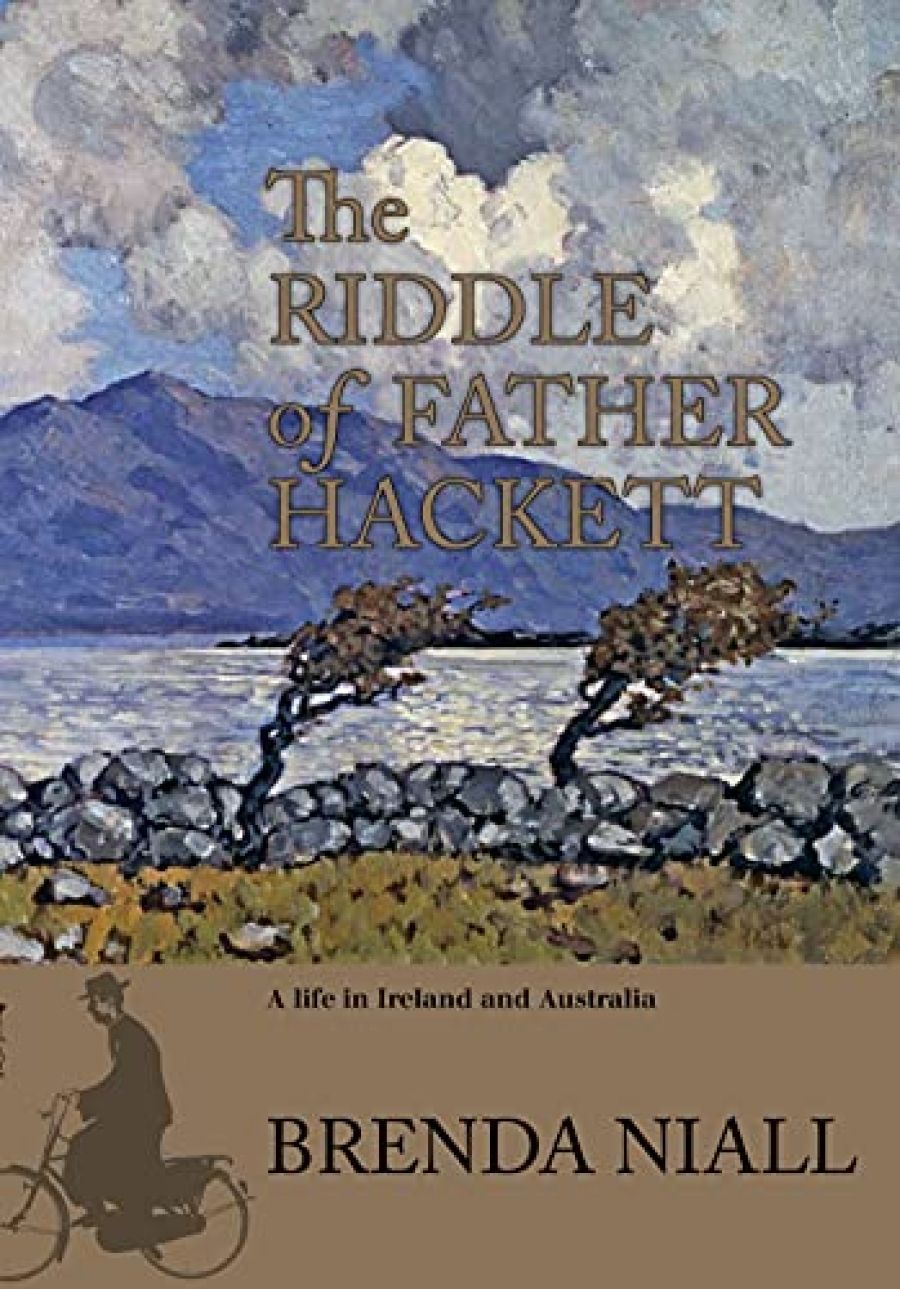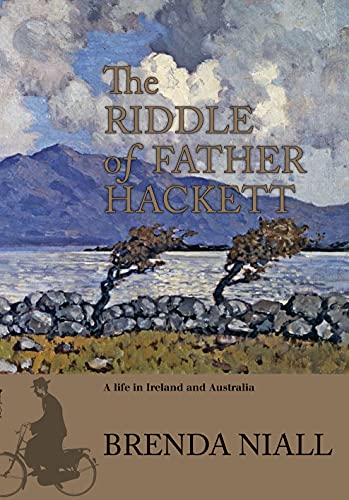
- Free Article: No
- Contents Category: Biography
- Review Article: Yes
- Article Title: Lifting the lid
- Online Only: No
- Custom Highlight Text:
Brenda Niall has the knack of lucid multi-focus, a great thing in a biographer. That organisational deftness, an ability to keep the tangled loops of people’s lives spooling freely through her fingers while she projects a rich and dramatic context for them, was evident in her group study of The Boyds (2002), and it is the structural virtue in this new work, The Riddle of Father Hackett.
- Book 1 Title: The Riddle of Father Hackett
- Book 1 Subtitle: A life in Ireland and Australia
- Book 1 Biblio: National Library of Australia, $39.95 pb, 320 pp, 9780642276858
- Book 1 Cover Small (400 x 600):

- Book 1 Cover (800 x 1200):

But nothing, not Jesuit rules, not concern for his own welfare, could keep the boundlessly energetic Hackett from the thick of things. As a young man and priest, he becomes part of the Republican struggle, a carrier of intelligence (looking pastoral as he peddles his bike around the country), an instigator of protest campaigns, a confidant of rebels and dissidents.
Like his Parnellite father before him, he makes friends of men destined to suffer, be imprisoned, die or be executed during the turmoil: men such as Michael Collins, Eamon de Valera and Erskine Childers. He consoles their families, and cherishes the bonds forged in suffering and friendship by writing letters throughout his life, letters that are free and intimate. When he is ‘exiled’ to Australia at the height of the civil strife (the reason for the exile is part of the intrigue of the man’s life, the ‘riddle’ of the title), the letters continue to flow back and forth.
It was these letters, among other personal records (eight boxes of them), preserved in the Jesuit archives in Melbourne, which convinced a sceptical Brenda Niall that she had the material for a biography. The impulse to write it was already there: Niall had known Father Hackett when, as a child, she quietly coveted the cigar box from which her father dispensed Havanas to the ‘restless, sociable’ priest who often came to visit their home in Melbourne’s Kew. She remembered him as a man who had ‘the invaluable quality of being exactly the same to children as to adults, to women as to men’.
Fond memories are one thing, and biography another. The archives, unusually full, confirmed Niall’s instinct that this was a life she could rediscover and reshape, and in writing, give the world back a kaleidoscope of human experience; of lives connected by events, by chance and by remarkable affinities. William Hackett was a bridge figure, a man gifted with friendship, who lived vigorously in both strife-torn Ireland and the Australia of early twentieth-century sectarianism, of Archbishop Daniel Mannix, of Herbert Vere Evatt, Arthur Calwell, of B.A. Santamaria, and the Movement.
In her acknowledgments, Niall notes particularly the advice about narrative given her by the late Greg Dening. ‘Write yourself in it,’ the renowned historian told her. ‘And I have,’ says Niall, with the air of a slightly naughty girl who has perhaps lifted the lid before all the cigars are gone. But her presence in the narrative is discreet, so restrained that when her occasional judgements come, they carry an easy burden of authority and familiarity. She has been there.
Niall knew her subjects: she was for a time a research assistant for Santamaria; she grew up in ‘Catholic’ Kew, opposite the Jesuit college on the hill; she lived through the Labor Split. She has long thought about these political quandaries, these complex people. She is penetratingly intelligent, but never at the expense of her characters. There is a touch of the Chaucerian about her: astute, but more inclined to explore than deplore the human foibles she delineates.
One of the many stories about Archbishop Mannix (who quickly annexed his Irish compatriot and sympathetic wit, William Hackett, as a companion) describes his deliberate soft speaking. When told that some of the hapless priests at the bottom of his formal table could not hear him, Mannix’s response was to speak even more softly. Brenda Niall’s voice in this biography is also soft and authoritative, but it is free of magisterial savagery. And her comments about Mannix, that extraordinary, isolated man who has eluded many a biographer (and who had his own papers burnt after his death) are among the wisest and most illuminating I have read.
In search of William Hackett and of the man behind or inside Mannix, Niall interviewed one of Mannix’s successors as archbishop of Melbourne, Frank Little. It was Little who finally sold Raheen, the cold mansion in which Mannix had long ago installed himself (to Dick Pratt, who could afford to fix the leaks), and thereby changed the style of archiepiscopal living in Melbourne. In 2007, Frank Little answered his own door, and told Brenda that ‘Frank’ was fine with him as a mode of address; that was if she felt comfortable with it herself.
To know Mannix better was to unlock some of the mystery of Niall’s subject. Hackett had variously been Mannix’s ‘only friend’ (Little’s view), the nimble Irishman able to speak unvarnished truth to the archbishop, but also a man whom Mannix treated not just as a privileged court jester but, occasionally, as a lackey. ‘The poodle goes with him’, wrote Hackett, in an uncharacteristically bitter burst of self-reflection.
Hackett, in Ireland, embodies a teasing knot of conflicting impulses. He is a loving brother and son, a genuinely pastoral priest, an ambitious and energetic political and social networker in times when alliances were dangerous, potentially fatal. He has his Jesuit authorities to answer to, but nonetheless involves himself in the Republican cause. The brutality of the Black and Tans during the Terror of 1920 horrifies him. He takes a group of English Quakers to witness the burnt buildings, and photographs the devastation, but can’t bring himself to photograph a charred corpse. He becomes close to the English Erskine Childers and his wife. He receives the last-known letter from Michael Collins, written on the eve of Collins’s death.
In the midst of the violence, he is bundled off to Australia. Against his will? By his own choice, perhaps, because the alternatives were to stay and cease his political involvement, or to leave? His letters show that he worries whether the going suggests cowardice. Hackett always worries, is always uncertain how to reconcile his humanity with his spiritual aspiration and commitment; his vivacity and ambition with his scouring self-examination.
In Australia, desperately lonely and a world away from Ireland, even within the ambit of Mannix, Hackett nonetheless reconstitutes a life that, in its webbed complexity, resembles the one he left behind. He becomes the friend and confidant of politicians across the political spectrum. When he can’t persuade Archbishop Mannix to invite the newly arrived English governor of Victoria, Lord Somers, to Raheen, Hackett takes Somers bushwalking and billy-boiling instead.
He establishes the Catholic Central Library and, like his father, is forever vague about how to keep his brave ventures solvent. He is popular but Micawberish about finances when he becomes rector of the Jesuit Xavier College. At the same time, he is a node for intellectual Catholicism, the Catholic Worker movement, the Campion Society, and Catholic Action. He sits uneasily between Mannix and his prodigious man of action, Santamaria.
Hackett is, in other words, a player. But how culpable, how responsible, how effective, how fulfilled? These were questions that the Everyman William Hackett asked of himself throughout his life. And in asking and answering them again, in a context that powerfully recreates the drama and complexity of a life amply lived in its times, Brenda Niall does him justice of the kind we might all wish for.


Comments powered by CComment